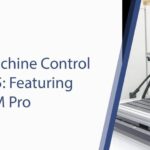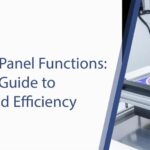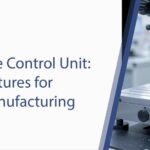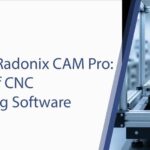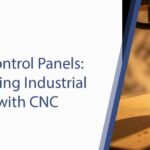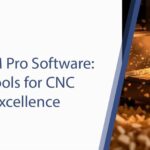In today’s competitive manufacturing landscape, the ability to produce complex, high-precision parts efficiently is paramount.
At the heart of this capability lies CNC milling software – the intelligent brain that translates your digital designs into the precise tool movements of a CNC mill.
This isn’t just about creating shapes; it’s about optimizing material removal, enhancing surface finish, minimizing waste, and significantly boosting your production capabilities.
This comprehensive article will explore the critical functions, key features, and immense benefits of CNC milling software, highlighting how Radonix’s cutting-edge control solutions seamlessly integrate with this technology to bring your designs to life.
Why is Specialized CNC Milling Software Indispensable for Modern Machining?
While CNC milling machines are powerful on their own, their true potential is realized only when paired with sophisticated CNC milling software.
This specialized software is crucial for several reasons:
- Unparalleled Precision and Surface Finish: Dedicated milling software allows for the generation of intricate toolpaths, precise control over cutting parameters, and complex geometric designs. This results in parts with tighter tolerances, superior surface quality, and minimal imperfections, essential for demanding industries like aerospace, medical, and automotive.
- Optimized Material Removal and Cycle Times: Advanced milling strategies, such as adaptive clearing, high-speed machining (HSM), and efficient roughing techniques, are embedded within the software. These optimize material removal, reduce overall machining time, and increase throughput, directly impacting profitability.
- Minimized Material Waste: Sophisticated nesting and material optimization algorithms ensure that parts are arranged on raw material blocks in the most efficient way possible, drastically cutting down on expensive material scrap.
- Handling Complex Geometries with Ease: From simple prismatic parts to complex 3D contours, multi-axis components, and intricate features, CNC milling software provides the tools to program precise movements for even the most challenging milling operations.
- Reduced Programming Errors and Setup Time: Automated feature recognition, robust simulation, and predefined machining cycles within the software drastically cut down on manual programming errors and reduce the time spent setting up jobs on the machine, leading to quicker turnaround times.
- Enhanced Tool Life and Machine Health: By optimizing cutting parameters (feeds, speeds, depths of cut, stepovers) for specific materials and tooling, the software helps reduce tool wear, extends tool life, and minimizes stress on the mill’s mechanical components, contributing to lower maintenance costs.
- Facilitating Prototyping and Customization: Quickly generate and test toolpaths for new designs or custom orders, making prototyping faster and more cost-effective. The ability to iterate rapidly is a significant competitive advantage.
In essence, CNC milling software is the intelligent engine that transforms a powerful milling machine into a highly efficient, precise, and profitable production powerhouse.
The Integrated Workflow: From CAD Design to Machined Part
The journey from a digital design to a finished milled part involves a seamless integration of design, manufacturing planning, and machine control.
CNC milling software plays a central role in orchestrating this entire process.
CAD (Computer-Aided Design) Phase: Defining the Part Geometry
- Purpose: This is where the part, its features, and overall dimensions are digitally created. While not strictly part of CNC milling software itself, it’s the preceding and essential step.
- Functionalities: Includes 2D sketching, 3D solid modeling, surface modeling, and assembly design. Users create precise geometric representations that capture every detail of the intended part. Features like fillets, chamfers, holes, pockets, and bosses are defined here.
- Output: A digital 3D model file (e.g., STEP, IGES, Parasolid, DXF, DWG, or native files from SolidWorks, Fusion 360, Inventor, etc.) that accurately represents the final part.
- Radonix Relevance: Our CNC mill controllers are designed to flawlessly execute the G-code derived from any standard CAD model, provided it’s processed correctly by CAM software.
CAM (Computer-Aided Manufacturing) Phase: Planning the Machining Process (The Core of CNC Milling Software)
- Purpose: This is the primary function of CNC milling software. It imports the CAD model, defines the raw material, selects cutting tools, and generates the precise toolpaths and cutting parameters.
- Key Functionalities for Mill CAM:
- Feature Recognition: Automatically identifying machinable features like pockets, holes, bosses, and complex surfaces from the imported CAD model.
- Toolpath Generation: Creating the path the milling cutter will follow to remove material. This is where the intelligence of the software truly shines. Common strategies include:
- 2D Machining: For profiling, pocketing, drilling, slotting, and thread milling on flat or prismatic parts.
- 5D Machining: Similar to 2D but with varying Z-depths, allowing for steps and levels.
- 3D Roughing: Quickly removing large volumes of material from the raw stock using various patterns (e.g., zig-zag, spiral, adaptive clearing) to bring the workpiece close to the final shape. Adaptive clearing is particularly efficient for hard materials.
- 3D Finishing: Generating toolpaths for light, precise cuts to achieve the final dimensions and desired surface finish on complex contoured surfaces. This includes parallel, scallop, spiral, and flowline finishing strategies.
- Multi-Axis Machining (4-axis, 5-axis): For machines with rotary axes, generating complex toolpaths that move the tool and/or workpiece simultaneously in multiple axes to machine intricate geometries in a single setup, reducing fixturing needs and improving accuracy.
- Tool Library Management: A comprehensive database of milling cutters (end mills, ball mills, face mills, drills, taps) with their geometry (diameter, length, flute count, helix angle) and recommended cutting parameters (feed rates, spindle speeds, depths of cut, stepovers) for various materials.
- Cutting Parameter Optimization: Automatically calculating and optimizing spindle speeds (RPM), feed rates, and depth of cut based on material type, tool properties, machine capabilities, and desired finish. Some advanced features include constant chip load and trochoidal milling.
- Workholding/Fixturing Definition: Defining vises, clamps, and other fixtures in the CAM environment to ensure collision detection is accurate during simulation.
- Nesting (for plate stock): For milling parts from sheet or plate material, intelligent nesting algorithms optimize the arrangement of multiple parts to minimize material waste.
- Simulation and Verification: A crucial step to prevent costly errors. The software simulates the entire milling process in a virtual environment, showing material removal, tool movements, and identifying potential collisions between the tool, workpiece, clamps, and machine components. This saves expensive material, valuable machine time, and prevents damage.
- Post-Processing: The final and most critical output of CNC milling software. It converts the generic toolpath data into specific G-code and M-code tailored to the unique syntax and requirements of your particular CNC mill’s controller. This customization is vital for successful machine operation.
- Popular CNC Milling CAM Software: Mastercam, GibbsCAM, Esprit, Fusion 360 (Milling module), SolidWorks CAM, FeatureCAM, Edgecam, HSMWorks, VCarve Pro (for 2D/2.5D routing).
- Radonix Relevance: Our CNC mill controllers are designed with extensive post-processor compatibility. They can flawlessly interpret G-code generated by all leading CNC milling software solutions, ensuring your precisely calculated machining operations are executed with optimal accuracy, speed, and surface finish.
CNC Control Software Phase: Executing the Machining Process (Radonix’s Core Strength)
- Purpose: This software (running on the CNC mill’s controller, often a dedicated hardware unit from companies like Radonix) is the direct interface between the G-code and the mill’s physical components.
- Key Functionalities:
- G-code Interpretation and Execution: Loading the G-code file and translating each line into precise electrical signals that drive the mill’s axes (X, Y, Z, and rotary axes), control the spindle, manage coolant, and activate other auxiliary functions.
- Real-time Monitoring: Displaying critical machine status, tool position, spindle speed, feed rate, current line of G-code, and overall program progress to the operator.
- Machine Setup and Zeroing: Allowing operators to establish machine home positions, set workpiece origins (G54-G59 offsets), and manage tool offsets (tool length and diameter compensation).
- Manual Control (Jogging): Enabling operators to manually move the mill’s axes for setup, inspection, or troubleshooting using buttons or a Handwheel (MPG).
- Spindle Control: Precise control over spindle RPM, direction, and spindle load monitoring.
- Tool Management: Managing automatic tool changes (for machines with tool changers) and applying correct tool offsets.
- Safety Interlocks and Emergency Stop (E-Stop): Implementing critical safety features that immediately halt machine operation in case of an emergency, limit switch triggers, or detected fault.
- Program Editing: Some control software allows for minor on-the-fly G-code edits.
- Machine Calibration: Fine-tuning motor parameters, backlash compensation, and other machine-specific configurations.
- Radonix Relevance: At Radonix, this is our core strength. We design and manufacture robust CNC mill controllers and develop highly optimized control software that acts as the intelligent conductor for your CNC milling operations. Our CNC milling control software is tailored for:
- Unrivaled Precision and Repeatability: Translating G-code into incredibly accurate and repeatable machine movements, crucial for consistent part production.
- Exceptional Reliability and Stability: Engineered for continuous, demanding industrial environments, minimizing downtime and ensuring steady production.
- Intuitive User Interface: Designed to be user-friendly, reducing operator training time and potential errors during setup and operation.
- Broad G-code Compatibility: Our controllers flawlessly execute G-code generated by the vast majority of CNC milling software solutions, ensuring smooth integration into your existing workflow.
- Advanced Safety Features: Prioritizing operator and machine safety with comprehensive interlocking and immediate emergency stop capabilities.
- Robust Diagnostic Tools: Providing clear feedback for efficient troubleshooting and maintenance.
Key Features to Prioritize in Your CNC Milling Software
When investing in CNC milling software, consider these essential features that will significantly impact your productivity, precision, and overall efficiency:
- Integrated CAD/CAM Workflow: The ideal solution offers seamless transition from design to toolpath generation within a single environment or with robust data exchange, minimizing conversion errors.
- Comprehensive 2D, 2.5D, and 3D Machining Strategies: Ensure the CAM component offers a wide array of toolpath options for various part geometries:
- Pocketing, profiling, drilling, slotting, thread milling for 2D/2.5D.
- Adaptive clearing, roughing strategies (zig-zag, spiral), and various finishing strategies (parallel, scallop, flowline) for 3D surfaces.
- Multi-Axis Capabilities (if applicable): If your mill has 4 or 5 axes, ensure the software can program complex, simultaneous multi-axis toolpaths efficiently and accurately, reducing multiple setups.
- Advanced Tool Library and Management: A robust library for various milling cutters, allowing for custom tool definitions, automatic parameter suggestions based on material and tool type, and management of tool wear and life.
- Cutting Parameter Optimization: The ability to automatically calculate and optimize feeds, speeds, and depths of cut for different materials and tool types to maximize tool life, improve surface finish, and reduce machining time. Features like constant chip load control are highly beneficial.
- Realistic Simulation & Verification: A high-fidelity simulation is paramount. It should accurately show material removal, tool movements, and, most importantly, detect potential collisions between the tool, workpiece, clamps, and machine components before any material is wasted or damage occurs. This is a crucial safety and cost-saving feature.
- Customizable Post-Processors: This is non-negotiable. The CAM software MUST be able to generate G-code specifically tailored to your CNC mill’s controller (like a Radonix controller). Verify that the software either includes a suitable post-processor or allows for easy customization/creation of one.
- Workholding Definition & Collision Avoidance: The ability to accurately define vises, clamps, and fixtures in the CAM environment to ensure collision detection is precise during simulation.
- Error Handling and Diagnostics: Software that provides clear error messages and diagnostic tools for both programming and simulation, guiding the user to troubleshoot issues effectively.
- Scalability and Updates: Does the software offer different tiers or upgrades as your skills and machine capabilities grow? Is it actively developed and updated to support new features, machine types, and operating systems?
- Technical Support & Community: Access to reliable technical support from the software vendor and an active user community is invaluable for learning, troubleshooting, and continuous improvement.
The Transformative Impact of CNC Milling Software on Manufacturing Workflows
The synergistic power of CNC milling software fundamentally transforms traditional manufacturing processes:
- Accelerated Product Development: Rapidly move from a design concept to a physical prototype or final part, significantly speeding up innovation and time-to-market.
- Reduced Manual Intervention: Automating complex calculations and toolpath generation frees up human operators to focus on supervision, quality control, and strategic tasks, rather than repetitive manual programming.
- Enhanced Repeatability and Consistency: Once a G-code program is generated and validated, it can be run countless times with identical results, ensuring high repeatability and uniformity in mass production, which is crucial for quality assurance.
- Cost Efficiency: Through material optimization, reduced machining time, lower scrap rates, extended tool life, and minimized human error, CNC milling software directly contributes to significant cost savings and increased profitability.
- Competitive Edge: Companies effectively leveraging integrated CNC milling software can offer more complex parts, higher quality products, faster turnaround times, and more competitive pricing, gaining a substantial advantage in the market.
Radonix controllers are specifically engineered to harness the full potential of these digital manufacturing pipelines. Our systems are built to process the sophisticated G-code generated by advanced CNC milling software, delivering the precision and performance your machining operations demand.
Radonix and Your CNC Milling Software Ecosystem
At Radonix, we recognize that our CNC control systems are a critical component within a larger CNC milling software ecosystem. Our commitment is to ensure seamless interoperability and maximum performance within this ecosystem.
- Universal G-code Interpretation: Our controllers are designed to interpret standard G-code formats generated by virtually all major CNC milling software packages. This means you have the flexibility to choose the CAD/CAM solution that best fits your design and programming needs, confident that a Radonix controller will execute it flawlessly.
- High-Performance Motion Control: Radonix systems employ advanced algorithms for smooth, high-speed, and precise motion control across multiple axes. This translates to superior surface finishes, tighter tolerances, and faster material removal rates.
- Unmatched Reliability and Stability: Built with industrial-grade components and rigorously tested, our controllers are designed for continuous, demanding operation in harsh manufacturing environments, minimizing downtime and maximizing productivity.
- Intuitive Control Interface: Our accompanying CNC control software provides a clear, user-friendly interface for loading programs, monitoring progress, and interacting with the machine, making the overall workflow efficient and accessible for operators of all skill levels.
- Dedicated Technical Support: When you choose Radonix, you gain a partner. Our expert technical support team is readily available to assist with integration, setup, and any questions related to running G-code generated by your CNC milling software on our controllers. Visit Radonix for comprehensive support resources and contact information.
The Future of CNC Milling Software
The evolution of CNC milling software is dynamic, with future developments promising even greater automation, intelligence, and integration:
- AI-Powered Process Optimization: Artificial Intelligence will increasingly assist in generative design, automatically creating optimized part geometries based on functional requirements. AI will also refine toolpaths, predict tool wear, and suggest optimal machining strategies based on real-time feedback and vast databases of cutting data.
- Predictive Maintenance and Self-Correction: Integration with machine sensors will allow software to predict potential mechanical failures (e.g., bearing wear, motor issues) and suggest proactive maintenance. Future systems might even self-correct toolpaths based on in-process metrology data to maintain tolerances.
- Cloud-Native Platforms: More CNC milling software will transition to cloud-based platforms, enabling remote collaboration, real-time data analysis, and seamless access from any device, integrating directly with MES/ERP systems for factory-wide data management.
- Enhanced Digital Twin Technology: Creating highly accurate virtual replicas of your CNC mill and the entire manufacturing process will allow for extremely precise simulations, predictive maintenance, and virtual commissioning of new programs before they ever touch the physical machine.
- Automated Quality Control: Direct integration with in-process metrology (measurement) devices will enable real-time quality verification, with feedback loops that can automatically adjust subsequent cuts to maintain tight tolerances or flag defective parts.
- Integrated Robotics and Automation: CAM software will facilitate easier programming of robotic arms for automated loading/unloading of parts, tool changes, and inspection tasks, further streamlining the manufacturing line.
Radonix is committed to staying at the forefront of these technological advancements, ensuring our CNC control solutions are ready to integrate with and harness the full potential of future CNC milling software.
Conclusion
CNC milling software is the indispensable intellectual engine behind every precise and efficient milling operation.
It’s the sophisticated tool that transforms your digital designs into perfectly machined components, driving efficiency, consistency, and innovation in manufacturing.
From the initial design phase in CAD to the meticulously calculated toolpaths in CAM and the final, precise execution by the CNC controller, this integrated software suite is crucial for success.
At Radonix, we understand this intricate ecosystem.
Our CNC control systems are engineered to be the robust, reliable, and intelligent command centers that flawlessly interpret the G-code generated by your CNC milling software, ensuring your digital designs are flawlessly translated into physical reality with superior precision and cut quality.
We are dedicated to providing the foundational control technology that allows your software investment to truly shine.
Discover how Radonix solutions can revolutionize your milling workflow. Visit Radonix for more information and to connect with our expert team.
Contact Us:
- E-Mail: info@radonix.com
- Phone: +90 (553) 920 5500


